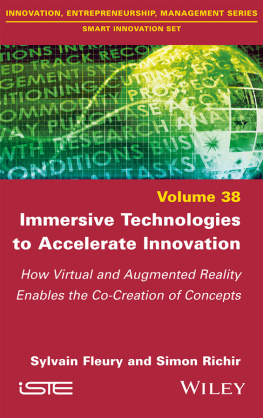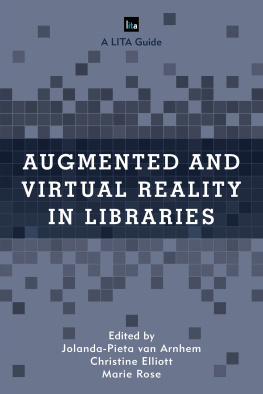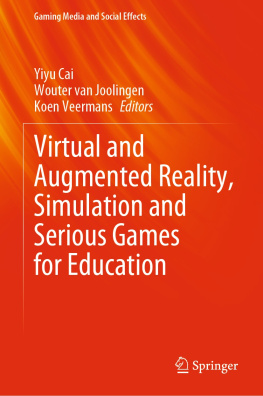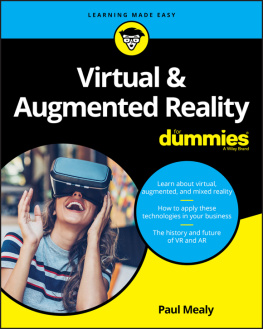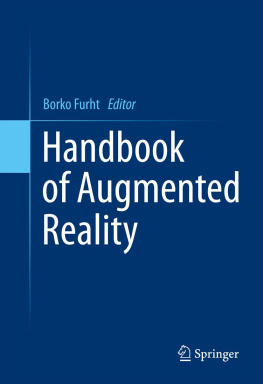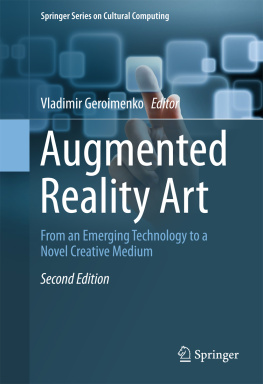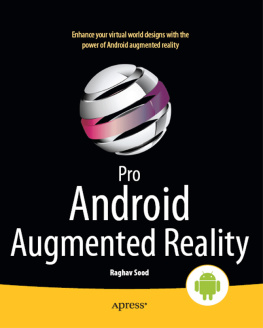COLOPHON
BIS Publishers
Het Sieraad Building
Postjesweg 1
1057 DT Amsterdam
The Netherlands
T +31 [0]20 515 02 30
www.bispublishers.com
ISBN 978 90 6369 470 8
EISBN 978 90 6369 528 6
AUTHOR
Galit Ariel, Amsterdam
EDITOR
Simone McKenzie, Toronto
COPY EDITOR
Jill Sheen, Amsterdam
CREATIVE DIRECTION & BOOK DESIGN
Galit Ariel, Amsterdam
CREATIVE DIRECTION & COVER DESIGN
Delux Design, Amsterdam
AUGMENTATION ART DIRECTION & APPLICATION
Nimi Ariel, Amsterdam
Copyright 2017 Galit Ariel and BIS Publishers.
All rights reserved. No part of this publication may be reproduced or transmitted in any form or by any means, electronic or mechanical, including photocopy, recording or any information storage and retrieval system, without permission in writing from the copyright owners.
Every reasonable attempt has been made to identify owners of copyright. Any errors or omissions brought to the publishers attention will be corrected in subsequent editions.
augmentingalice.com
Preface
Hello, Spatial Explorers!
This book was written with the intent to contextualise and futurescape Augmented Reality applications, considering the technologys implementation potential, challenges and risks. Whether you are an Augmented Reality or Virtual Reality developer, content creator or consumer, Augmented Reality will play a major role in our [near and far] future experiences and interactions. Immersive tech and Augmented Reality in particular has the potential to become a universal experience platform, that could be either beneficial or detrimental to societal, economic, political, identity, cultural and experiential systems.
I chose to reference Alices Adventures in Wonderland as a framework, as this masterpiece of popular literature describes the adventures of Alice as she explores new aspects of reality and confronts her own limitations in a virtual world. Lewis Carroll the pen name of Charles Lutwidge Dodgson was a mathematician who explored the way we adhere to culture, politics and identity in a manner that was ground-breaking for its time, and still relevant today. If technology and new media could offer us a window into wonderland, Augmented Reality would enable wonderland to travel through the rabbits hole and become a layer within our physical space, altering our sense of reality, identity and culture.
We may have normalised the presence of a constant digital influence, believing that we can filter and disconnect from technology at will. If this is even partially true, Augmented Reality will be a transformative technology, one that will forge such an immersive experience, embedded within our spatial and bodily spheres, creating a seamless physical-virtual flow a reality with a digital layer implemented within it everywhere, and all the time. This is not a prophecy for a distant future. We are on the verge of this new era, and we must be prepared for it the augmented era.
I Am a Nerd.
Being a self-proclaimed nerd has finally become a badge of honour. A hypothetical passport that grants you passage to the land of the new tech elites. Nerds have moved away from the social fringe, and now represent mainstream future builders, members of the start-up crowd, the innovators, the social disrupters, the unicorn breeders, and leaders of a new social and economic order.
Growing up, I had no doubt that the alternate sociotechnical futures as described by my personal holy sci-fi trinity Isaac Asimov, William Gibson and Phillip K. Dick could materialise. What drew me to their writing was that they did not focus on the science behind future technologies, but how vividly they could envision and describe the complexities, challenges and consequences of applying future technologies within the context of complex human mechanics on the mental, social and moral level. Their vision can guide us as we navigate near- and far-future zeitgeist, social conflicts and systems put in place to regulate human-machine-digital interaction.
My personal interest [or should I say obsession] with other realities began as a child on board the USS Enterprises Holodeck. It was such an incredible notion for me that technology could enable exploring alternative, infinite environments and experiences. But alas, all of this was happening light years away, on a spaceship, and I had no clue how to get drafted into the Federations Intergalactic Fleet. I did try to research the subject, but it was quite challenging with only a dial-up Internet connection.
You should never underestimate nerds and their science fiction, as they play a pivotal role in stimulating technology and creativity. Science fiction is the ultimate playground for true innovators to seed ideas without being restricted by mechanical, operational and financial issues. And so, I consider myself lucky to be one of the nerds who lives to see how the fiction layer is peeled off science fiction novels. We are witnessing how emerging technologies that were previously considered sci-fi concepts have materialised, and been integrated into our everyday lives including the World Wide Web, mobile devices, Real-Time streaming, Artificial Intelligence, and, of course, Virtual Reality and Augmented Reality.
During my design studies in the 1990s, ideas about invisible computing technologies, Augmented and Virtual Reality were being explored, and were even being prototyped. My childhood dreams were suddenly being transformed into a tangible technology tool, but still out of reach - living only in research labs, with early prototypes that were not available or ready for mass implementation. My technology calling was yet to be realised, and I entered the working world as an industrial designer. After sharpening my skills on a varied portfolio of brand and product design strategies, I decided to concentrate on my Masters degree in technology innovation focusing on a social and user-engagement lens.
Along the way, I married a 3D game designer of course! And halfway through my degree, he walked into our home carrying the best thing a 3D sapient can bring his wife an Oculus Rift Development Kit. He cleared his throat and said, Honey, this is it. Virtual Reality is here. And its ready to change our lives. I adjusted the Oculus goggles, and was ready to be immersed in my lifelong fantasy of a parallel universe.
And then all of my childhood fantasies came crashing down around me. Where were these alternative, immersive and inspiring worlds? Instead, I had a mildly engaging experience that felt more like a party trick than transcending to another dimension. The visual feedback was disorientating and in fact I became quite bored. I took off the clunky headset and was left feeling disillusioned, disappointed, and with a mild headache. I did not expect the technology to offer a high-fidelity experience, but I questioned the Virtual Reality itself. My husband shrugged, and told me that I am simply experiencing it wrong. And so began our family feud.
Like every nerd challenged by a feud or a sense of disappointment, I sat down to write a paper that would explore Virtual Reality as an innovation platform. I was hoping to find out what should happen within this Virtual existence, but mostly I wanted to have an academic argument proving that I was not experiencing it wrong. My conclusions drove me to shift my academic and professional focus towards augmented implementation strategies.


